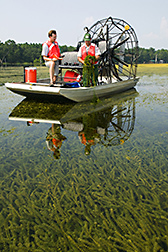|

U.S. Army Corps of
Engineers personnel collect herbicide-resistant hydrilla from Lake Seminole in
northern Florida. Click the image for more information about
it.
|
Scientists Mobilize Fungus to Fight
Hydrilla
By Jan
Suszkiw April 13, 2006
Even the toughest weeds have their mortal enemies. For hydrilla, it's
Mycoleptodiscus terrestris. Now, scientists' efforts to turn this fungal foe
into a biological control agent could prove even deadlier to the aquatic weed.
Agricultural Research Service (ARS) microbiologist
Mark
Jackson and U.S. Army Corps of Engineers (USACE) plant pathologist Judy Shearer
chose the fungal pathogen for its specificity and cell-wreaking attacks on
hydrilla. Mark Heilman of SePRO Corp.,
Carmel, Ind., is collaborating with them to try and commercialize the fungus as
a biological herbicide.
Originally sold in the 1950s for aquarium use, hydrilla has become a
noxious weed of lakes, rivers, canals and other water systems across the
southern United States and in Atlantic and Pacific coast states. Its dense mats
can clog drainage and water-intake systems, impede boating and degrade fish and
wildlife habitat.
Herbicide spraying is the chief means of battling hydrilla, though few
herbicides are registered for the task. Fluridone is among the most effective,
but in parts of Florida and Georgia, prolonged use has brought about resistant
strains of hydrilla, increasing treatment costs and impacting performance,
notes Shearer, with USACE's Army
Engineer Research and Development Center, Vicksburg, Miss.
Since 2000, Shearer and Jackson, with ARS'
National
Center for Agricultural Utilization Research, Peoria, Ill., have
collaborated on developing M. terrestris for integration with chemical and
cultural hydrilla-control strategies. In May 2003, their efforts led to a
patented new method (6,569,807) of culturing the fungus and "coaxing" it to
form tiny, filamentous clumps called microsclerotia. Studies have shown that
microsclerotia withstand the rigors of drying and prolonged storage better than
the fungus' spores.
Fortunately, they're just as deadly to hydrilla. When dusted onto
potted hydrilla in aquarium trials, the microsclerotia reduced plants'
above-ground growth by 99 percent. In December 2005, SePRO licensed the
scientists' formulation techniques, though testing continues to determine which
bioherbicide formulation works best. Once found, it'll undergo larger-scale
testing, including small ponds at
USACE's Lewisville
(Texas) Aquatic Ecosystem Research Facility.
ARS is the U.S. Department of
Agriculture's chief scientific research agency.